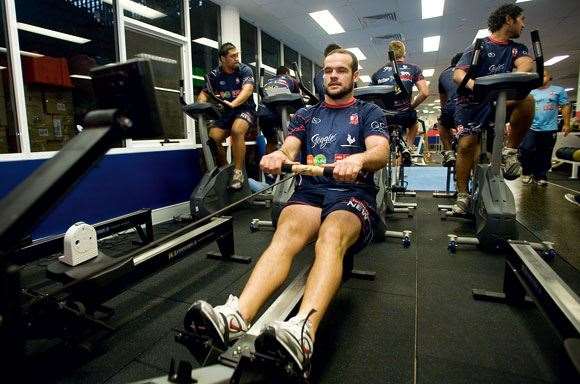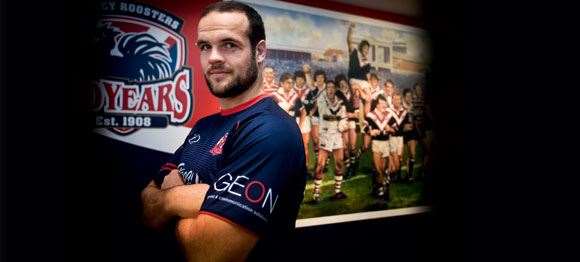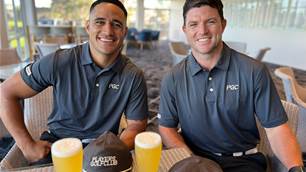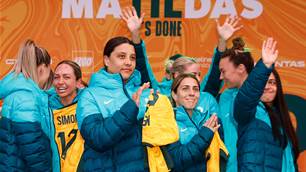For the most up-to-date slant on the physical attributes required of leaguies, you’re best to speak to Sydney Roosters workhorse Nate Myles.
For the most up-to-date slant on the physical attributes required of leaguies, you’re best to speak to Sydney Roosters workhorse Nate Myles.
 “I made sure I kept turning the legs over at Christmas so that when I came back I felt a lot better for it.” Images: Warren Clarke
“I made sure I kept turning the legs over at Christmas so that when I came back I felt a lot better for it.” Images: Warren ClarkeFor a revealing insight into the evolution of Homo Sapiens over the last 50,000-100,000 years, fly to New York and check out the American Museum of Natural History’s Human Origins exhibition. For a more modern summary, of not so much human evolution, but of changing body shapes in sport, cast your eye over any rugby league match footage pre-dating 1960 (those “big” blokes, the size of today’s three-quarters, they’re the props). But for the most up-to-date slant on the physical attributes required of leaguies, you’re best to speak to Sydney Roosters workhorse Nate Myles.Myles, picked again this year to partner the likes of Petero Civoniceva and Dave Taylor in the Queensland Maroons’ thunderous engine room, is living proof that today’s on-demand society and possibilities haven’t been lost on NRL coaches. Upon his arrival at the disgrace-stricken, wooden spoon-winning Bondi club, new chooks clipboard-holder Brian Smith saw what everyone else did in Myles, a damaging prop. But he needed something else – speed, an extra attacking option – and went about transforming the Cairns product to fit in with whatever schemes were on his drawing board. Gone are the days of coaches and recruiters’ options being limited to raiding the prop shop for established big men, or the wing ranks for a player with pace – modern NRL stars must be turned into whatever they need to be.
Myles’ reconfiguration between the final game of the 2009 season and the opening match of this year’s campaign may have cost him 10kg, but he’s lost nothing in terms of impact and contribution to the Roosters’ cause. Used predominately as a lock forward/second-rower, a leaner, speedier Myles upped his work rate to sit in the NRL’s top five of tackles made and top 20 in metres gained during the opening-to-middle stages of the 2010 season.Well-publicised alcohol-fuelled episodes which don’t need to be expanded upon here cost him six games through suspension in 2009, but the Roosters’ new man’s only worries in 2010 appear to be contending with coach Smith’s increased demands, and hurtling his club towards the opposition line and towards a return to semi-final football. His five 70-minutes-and-over efforts during rounds 1-10 of this year’s NRL caught the eye of Australia’s selectors, who made him the ‘Roos’ 18th man for the recent Trans Tasman Test in Melbourne. Myles, well and truly on a mission to prove he’s on the road to redemption in 2010, was kind enough to share a few of his off-season weight-loss secrets with Inside Sport.
BIG CHANGES
“Over the off-season the club went through a big transformation – the whole coaching staff, a few new players in key positions, etc. After the 2009 season all the players had individual meetings with the new head coach, Brian Smith. He let me know he had a positional change in mind for me in 2010. He wasn’t going to play me in the front row any more – I’d be playing more in the back row/lock area, which means a different role on the field. I knew I’d be playing a lot more minutes per game this year.
“I probably would’ve been able to play in the back row at my old body weight, but it’s a bit safer for the team for me to play a bit lighter so I can last a lot longer each game.
“It was actually a mutual decision between the coaching staff and me for me to play lighter. I had to plan it out and work out what weight I wanted to get to. It’s been a different training regime for me in that I’ve been speed-coached as well.”
 “A change in my diet was a big factor for my weight loss."
“A change in my diet was a big factor for my weight loss."Images: Warren Clarke
MAKING THE MOVE
“I can sit here and say that I’ve moved from the front row to lock, but in our team the real main difference between the positions is playing minutes per game. I get to pass the ball a bit more now, too, but it’s not as if I’ve had to turn into a ball-playing footballer. I’m still getting through the hit-ups that I’ve always had to do, I just have to do it for almost the entire game now. That means being a bit fitter and a bit lighter.”
BATTLE PLAN
“The Roosters’ training staff designs all the players’ pre-season programs – running, weights regimes ... This off-season was a lot more specific to each player’s role on the field, whether you’re an outside back or fullback, who worked on their speed, whereas the forwards did a lot more wrestling-type work. Very specific work to our positions.”
WHAT WORKED
“Anything cardio-focussed in the weights room is effective for weight loss. You can’t beat running. It’s definitely the best exercise fitness-wise for us. In the weights room we’re usually getting on the bike or the stepper or the treadmill. I’m not a big fan of the rower, but you do it and you can feel it working … You’re puffing like hell after a session on it."
“It’s all high-intensity work when fitness is concerned. More efforts for less time. During the off-season our field sessions usually lasted about an hour and a half. In the middle of a warm-up and warm-down we’d complete a lot of game-orientated stuff – it’s great for improving fitness; fast activities like touch football at a high pace."
“It was never just time trial-type running. You know, ‘Run this far in a certain time,’ for example. A lot of the work I did on the bike involved 20 seconds-hard, level 13 or 14, before tapering down. Then the same time off before another intense burst. Just turning the legs over.The same went for rowing and the other machines and exercises. It was never long, endurance-based work, but high-intensity and high-repetition training.”
NO MORE JUNK
“A change in my diet was a big factor for my weight loss. I was really cautious in watching what I was eating. I stayed away from the likes of Macca’s and shied away from nipping down the road and getting a hamburger. I got right into seafood; I started really enjoying salmon. Cooking at home is a big key to dropping kilos. You can really keep an eye on what you’re eating. I love roast chicken and veggies. It’s pretty easy to cook. You can’t go wrong there. A few potatoes for carbohydrates … We can always trust George and his staff at Azure Cafe at the SFS, too. But generally, if you’re eating out all the time, you don’t know how the food you’re eating is being prepared.”
TOO LIGHT?
“In saying all this, a player can definitely lose too much weight, especially if you’re in a position like prop forward. We have a player at our club at the moment who I think is a little bit too light. You can see them getting dominated at times in tackles, etc, which can happen to any player who’s performing at a weight they’re not used to. I’ve never found playing too light a problem, though!”
 Nate Myles
Nate MylesImages: Warren Clarke
GOOD BOY FOR SANTA
“I was a good boy over Christmas. I went back to my hometown of Cairns for the whole two weeks we had off. I was pretty disciplined with training. Seeing as though I was on a break, I didn’t do much training by our standards, but I made sure I kept turning the legs over so that when I came back I felt a lot better for it.
“I did a bit of weights with my brother and stuck to a similar weights program to what we regularly do at the Roosters. There was a little bit a cardio, but mainly I tried to stay off my legs because I knew there’d be plenty of running for us to do when we all got back to training in January. So doing work on the bike in the gym up in Cairns was really effective.”
RIGHT TOOLS
“I think supplements I was taking during pre-season, and still do, definitely played their part in helping me achieve my playing weight goal. One of my supplements, LipoBurn Hardcore, has therapeutic doses of various herbal extracts. It’s got Guarana in it, which is a natural source of caffeine, and other good stuff – it’s supposed to help reduce appetite and sugar cravings and stimulate fat metabolism.
“I also take Melibol Branch Chain Amino Acids 2200, or BCAAs for short. They say they’re different from regular proteins because they’re metabolised in the muscle rather than in the liver. Ideally you burn mostly fat and store carbs as fuel, but later your body also relies on protein, especially BCAAs, as your carbs burn up. When you run out of BCAAs it speeds the breakdown of muscle glycogen, which you don’t want, because then you are ‘hitting the wall’, so this supplement is a big help. I also take HydroxyBurn Pro. It’s another protein supplement but it’s released slowly, so it burns fat but feeds the muscles.
“And I also take Multi VMA. It’s a real energizer with heaps of vitamins, minerals and nutrients. It’s supposed to be really good for people with stress and poor diet.
“I hadn’t taken supplements before the last off-season; I’d never had to push through the minutes I am now or perform
a role where I have to do a lot more work. Besides, playing in the front row, I never had to worry about my weight too much.”
FEELING THE EFFECTS
“There are products out there on the market where you can actually feel the effects on your system. They make you want to be active and get active. They give you a bit of a buzz, which is handy. You hit the weights, you rip in and you’re training at a high intensity. With supplements like LipoBurn, though, you can’t really notice how they’re helping you. You take them in the morning or at lunch … if you have them too late in the day you certainly stay awake for a while because of their caffeine content."
“They can be good for boosting your immune system, too, which is really important for athletes. Time off the field because of colds or flu-type stuff affects the team and can also cost you a spot in the side if you’re off while an understudy performs well while you’re away.”
– James Smith
Related Articles

Viva Las Vegas: Join Golf Australia magazine's Matt Cleary on a golf and rugby league spectacular

19 Holes With ... Chad Townsend and Val Holmes













